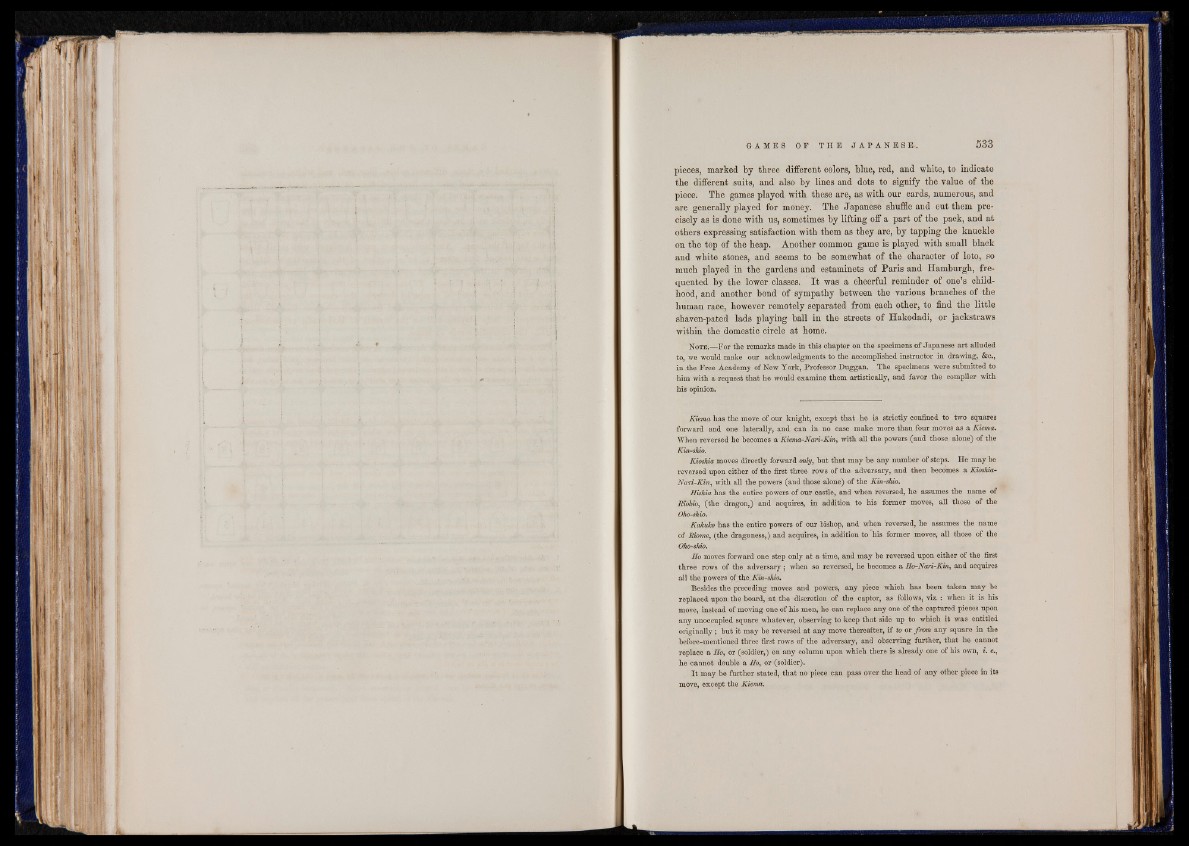
pieces, marked by three different colors, blue, red, and white, to indicate
the different suits, and also by lines and dots to signify the value of the
piece. The games played with these are, as with our cards, numerous, and
are generally played for money. The Japanese shuffle and cut them precisely
as is done with us, sometimes by lifting off a part of the pack, and at
others expressing satisfaction with them as they are, by tapping the knuckle
on the top of the heap. Another common game is played with small black
and white stones, and seems to be somewhat of the character of loto, so
much played in the gardens and estaminets of Paris and Hamburgh, frequented
by the lower classes. I t was a cheerful reminder of one’s childhood,
and another bond of sympathy between the various branches of the
human race, however remotely separated from each other, to find the little
shaven-pated lads playing ball in the streets of Hakodadi, or jackstraws
within the domestic circle at home.
Note.—For the remarks made in this chapter on the specimens o f Japanese art alluded
to, we would make our acknowledgments to the accomplished instructor in drawing, &e.,
in the Free Academy of New York, Professor Duggan. The specimens were submitted to
him with a request that he would examine them artistically, and favor the compiler with
his opinion.
Kiema has the move of our knight, except that he is strictly confined to two squares
forward and one laterally, and can in no case make more than four moves as a Kiema.
When reversed he becomes a Kiema-Nari-Kin, with all the powers (and those alone) of the
Kin-sMo.
Kioskia moves directly forward only, but that may he any number of steps. He may be
reversed upon either of the first three rows of the adversary, and then becomes a Kioshia-
Nari-Kin, with all the powers (and those alone) of the Kin-shio.
ffishia has the entire powers of our castle, and when reversed, he assumes the name of
RioMo, (the dragon,) and acquires, in addition to his former moves, all those of the
Oho-shio.
Kakuko has the entire powers of our bishop, and when reversed, he assumes the name
of Riorne, (the dragoness,) and acquires, in addition to his former moves, all those of the
Oho-shio.
Ho moves forward one step only at a time, and may be reversed upon either of the first
three rows of the adversary; when so reversed, he becomes a Ho-Nari-Kin, and acquires
all the powers of the.ATm-s^io.
Besides the preceding moves and powers, any piece which has been taken may be
replaced upon the board, a t the discretion of the captor, as follows, viz.: when it is his
move, instead of moving one of his men, he can replace any one of the captured pieces upon
any unoccupied square whatever, observing to keep that side up to which it was entitled
originally ; but it may be reversed at any move thereafter, if to or from any square in the
before-mentioned three first rows of the adversary, and observing further, that he cannot
replace a Ho, or (soldier,) on any column upon which there is already one of his own, i. e.,
he cannot double a Ho, or (soldier).
It may be further stated, that no piece can pass over the head of any other piece in its
move, except the Kiema.